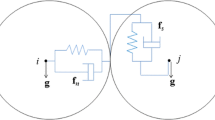The failure of dikes is mostly caused by the development of piping. Whether or not piping erosion develops is mainly determined by the critical hydraulic gradient. In this paper, a multi-particle model for the critical hydraulic gradient of dike piping is derived. The model is based on the Terzaghi formula, and considers particle size distribution characteristics and the interaction between the sand sample and the water flow. Using a global sensitivity analysis of the model, it was found that the determinants of piping occurrence are mainly the physical characteristics of the soil particles and the particle size distribution characteristics. Laboratory tests and a field case analysis (in China) of piping were carried out. The derived model was found to perform better than Terzaghi's model.
Similar content being viewed by others
References
R. Fell and J. J. Fry, "The state of the art of assessing the likelihood of internal erosion of embankment dams, water retaining structures and their foundations," Internal Erosion of Dams and Their Foundations, Taylor & Francis, London (2007).
K. S. Richards and K. R. Reddy, "Experimental investigation of piping potential in earthen structures," Geotech. Spec. Publ., 178, 367-376 (2008).
D. V. Zyl and M. E. Harr, "Seepage erosion analyses of structures," Proc. 10th Int. Conf. Soil Mech. and Found. Eng., Stockholm, 20(2), 503-509 (1981).
Z. V. Terzaghi, "Experimental investigation of the pressure of a loose medium on retaining walls with a vertical back face and horizontal backfill surface," Soil Mech. Found. Eng., 2(4), 197-200 (1965).
J. B. Sellmeijer and M. A. Koenders, "Mathematical Model for Piping," Appl. Math. Modell., 15(6), 646-651 (1991).
C. S. P. Ojha, V. P. Singh, and D. D. Adrian, "Influence of porosity on piping models of levee failure," J. Geotech. Geoenviron. Eng., 12(1071), 1071-1074 (2001a).
C. S. P. Ojha, V. P. Singh, and D. D. Adrian, "Determination of Critical Head in Soil Piping," J. Hydraulic Eng., 129, 511-517 (2003).
C.-X. Mao, X.-B. Duan, and L.-J. Wu, "Study of critical gradient of piping for various grain sizes in sandy gravels," Rock Soil Mech., 30(12), 3705-3709 (2009).
A. Bernatek-Jakiel, W. Vannoppen, and J. Poesen, "Assessment of grass root effects on soil piping in sandy soils using the pinhole test," Geomorphology, 295, 563-571 (2017).
S. Wang, J.-S. Chen, H.-Q. He, et al., "Experimental study on piping in sandy gravel foundations considering effect of overlying clay," Water Sci. Eng., 9(2), 165-171 (2016).
K. Dolzyk and I. Chmielewska, "Predicting the coefficient of permeability of non-plastic soils," Soil Mech. Found. Eng., 51(5), 213-218 (2014).
B. Indraratna, V. T. Nguyen, and C. Rujikiatkamjorn, "Assessing the potential of internal erosion and suffusion of granular soils," J. Geotech. Geoenviron. Eng., 138(6), 550-554 (2012).
M. Maknoon and T. -F. Mahdi, "Experimental investigation into embankment external suffusion," Nat. Hazards, 54(3), 749-763 (2010).
R. Moffat, J.F. Fannin, and S. Garner, "Spatial and temporal progression of internal erosion in cohesionless soil," Can. Geotech. J., 48(3), 399-412 (2011).
N. W. Atallah, A. Shakoor, and C. F. Watts, "Investigating the potential and mechanism of soil piping causing water-level drops in Mountain Lake, Giles County, Virginia," Eng. Geol., 195, 282-291 (2015).
K. Terzaghi, Theoretical Soil Mechanics, Wiley, New York (1943).
R.-F. Cui, "Study on the permeability characteristics of non-cohesive soil and its mechanism of piping failure," M.Sc. thesis, Ho Hai University, Nanjing, China, 66-86 (2006).
B. Aberg, "Hydraulic conductivity of noncohesive soils," J. Geotech. Eng., 118(9), 1335-1347 (1992).
F. Campolongo, A. Saltelli, and J. Cariboni, "From screening to quantitative sensitivity analysis. A unified approach," Comput. Phys. Commun., 182, 978-988 (2011).
S. Briola, P. D. Marco, R. Gabbrielli, et al., "Sensitivity analysis for the energy performance assessment of hybrid compressed air energy storage systems," Appl. Energy, 206(15), 1552-1563 (2017).
M. Leonelli, C. Gorgen, and J. Q. Smith, "Sensitivity analysis in multilinear probabilistic models," Inform. Sci., 411, 84-97 (2017).
C. Chisaria, G. Rizzano, C. Amadio, et al., "Sensitivity analysis and calibration of phenomenological l models for seismic analyses," Soil Dynam. Earthq. Eng., 109, 10-22 (2018).
J. Hall, S. Boyce, R. Dawson, et al., "Sensitivity analysis for hydraulic model," J. Hydraulic Eng., 135 (11), 959-969 (2009).
F. Campolongo, J. Cariboni, and A. Saltelli, "An effective screening design for sensitivity analysis of large models," Environ. Modell. Software, 22, 1509-1518 (2007).
J.-R. Marc and Jan Kwakkel, "Tree-based ensemble methods for sensitivity analysis of environmental models: A performance comparison with Sobol and Morris techniques," Environ. Modell. Software, 107, 245-266 (2018).
S. Wang, J. -S Chen, Y. -L. Luo, et al., "Experimental investigation of the erosion mechanisms of piping," Soil Mech. Found. Eng., 52(5), 301-309 (2015).
S. Wang, J. -S. Chen, Y. -L. Luo, et al., "Experiments on internal erosion in sandy gravel foundations containing a suspended cutoff wall under complex stress states," Nat. Hazards, 74(2), 1163-1178 (2014).
J. Liu, D. -S. Xie, and Y. -H. Cui, "Destructive tests on piping failure of sandy gravel layer of river dikes," Chin J. Geotech. Eng., 31(8), 1188-1191 (2009).
A.-J. Deng, Q.-C. Guo, and J.-G. Chen, "Study on the roughness in sediment-laden flows," J. Sedim. Res., 5, 24-29 (2007).
Author information
Authors and Affiliations
Corresponding author
Additional information
Translated from Osnovaniya, Fundamenty i Mekhanika Gruntov, No. 3, p. 11, May-June, 2020.
Rights and permissions
About this article
Cite this article
Ming, P., Lu, J., Cai, X. et al. Multi-Particle Model of the Critical Hydraulic Gradient for Dike Piping. Soil Mech Found Eng 57, 200–210 (2020). https://doi.org/10.1007/s11204-020-09656-1
Published:
Issue Date:
DOI: https://doi.org/10.1007/s11204-020-09656-1




